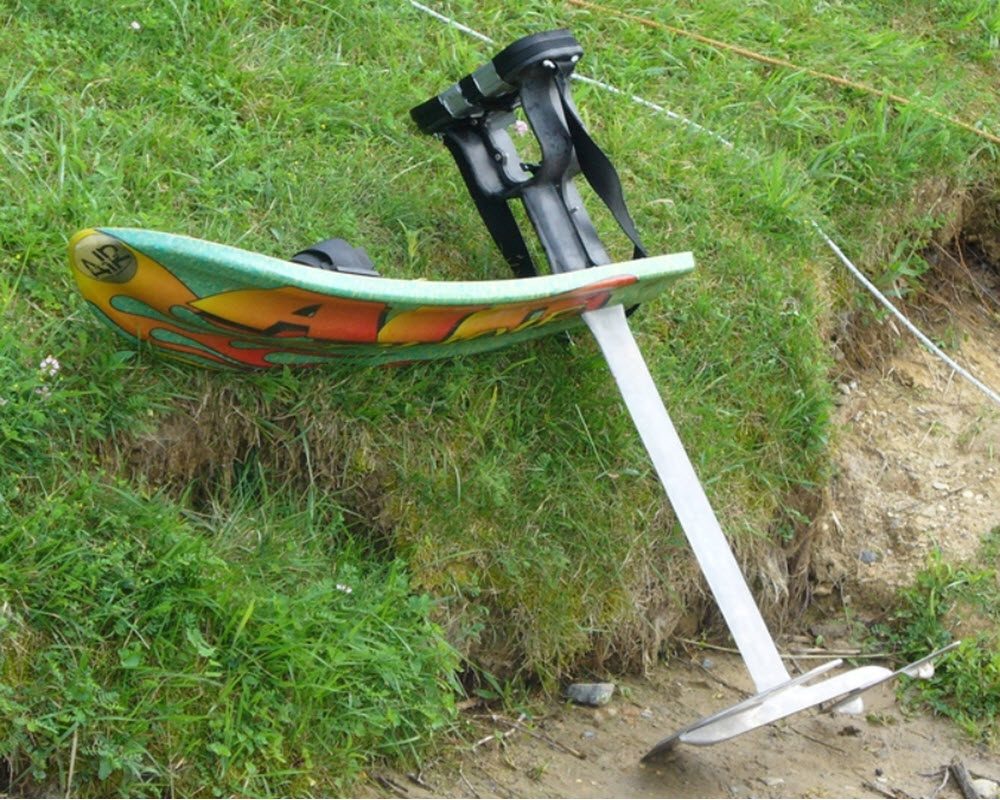Contents
With a sit-down hydrofoil, you sit-down and ride the water behind a powerboat or other towing vessel. As you pick up speed, the board of the hydrofoil will “fly” just sligthly above the surface of the water. This means that your ride isn’t heavily impacted by wake or chop. Also, compared to sports such as water skiing, less strenght is required since the resistance is lower.
The sit-down hydrofoil consists of three main parts:
- The seat, also known as the towerThis is the part that you sit on. It is located above the hydrofoil, and is typically made from aluminium. There is a seat-bealt that you can use to make sure you and the sit-down hydrofil don’t get separated from each other during the ride.
- The boardThis is a molded ski. It has two bindings that you attach to your feed to better control the ride. The board is usually made from either fiberglass or carbon fiber resin.
- Foil assemblyThis is a long strut connected to a fuselage carrying a frong wing and a rear wing. The strut is usually around 3 feet long. The front wing is what gives the sit-down hydr ofoil its ability to be lifted up above the water. The rear wing is needed to provide stability.
Some basics about sit-down hydrofoiling
- You sit down during the ride (unless you have one of the combo models where you can alternate between sitting down and standing up).
- You are attached to the sit-down hydrofoils with a seat belt, and your feet are strapped into bindings near the front of the board. If you fall, you will still be attached to the sit-down hydrofoil. Wearing a suitable life jacket is very important.
- Your body should be centred over the post of the hydrofoil. Remember that even a small body movement can have a major impact on the hydrofoil. If you want to “float upward”, lean back. To go down again, either lean forward or push down with your feet.
- To turn, simply point your knees in the desired direction.
- Hydrofoiling in very shallow waters is hazardous, since the hydrofoil can run into the bottom or into submerged objects.
- The ski line should be at least 75 feet / 23 meters long.
What speed is recommended?
For beginners, a speed of 13-16 knots is recommended (approximately 15-18 miles per hour).
When you are more experienced, you can gradually increase the speed. Many skilled performers prefer a speed of 19-26 knots (circa 22-30 mph), since increased speed makes it possible to attain extra heigh and length for tricks that involves jumping.
What’s an air board?
An air board is a modified hydrofoil where you stand up instead of sitting down.

Background
What are hydrofoils?
A hydrofoil is a lifting surface (foil) that operates in water. As a hydrofoil craft gains speed, the hydrofoil lifts the craft out of the water, which decreases drag and allows for higher speeds.
The first evidence of a hydrofoil on a vessel is found on a British patent granted to the French inventor Emmanuel Denis Farcot in 1869.
The first waterski hydrofoil
Hydrofoil boats have been in use since the early 20th century, but the first waterski hydrofoil wasn’t created until the early 1960s when the aeronautical engineer Walter Woodward attached two skis to a bi-wing hydrofoil.
The first kneeboard hydrofoil
In 1972, Mike Murphy and Bob Woolley attached a surfing kneeboard to a bi-wing hydrofoil. Later, they reduced the bi-wing to a single wing.
The first sit-down hydrofoil
The aforementioned Murphy and Woolley continued with their hydrofoil experiments, and eventually created the first “Sit Ski”: a sit-down hydrofoil. Woolley rode it for the first time in 1984.
After trying out several different materials and tinkering with the “Sit Ski” in various ways, Murphy and Woolley renamed their invention “Air Chair”. At this point, it even had a seat belt. Murphy and Woolley sold their first Air Chair in 1990.
Today
Since then, the sit-down hydrofoil has been improved further, partly thanks to new materials that have become readily available. It is today possible to buy a very strong sit-down hydrofoil with shock absorbers in the seat (for a more pleasant ride) and a high degree of manoeuvrability. Combos that are suitable for both sit-down and stand-up are also available.
